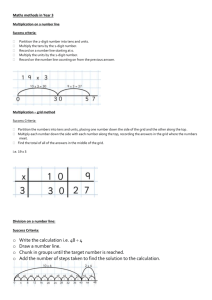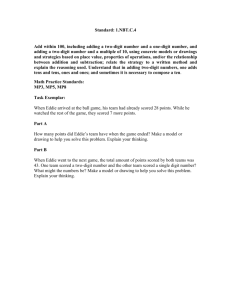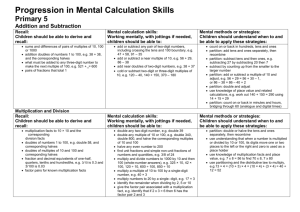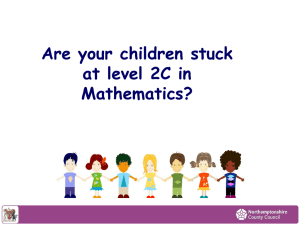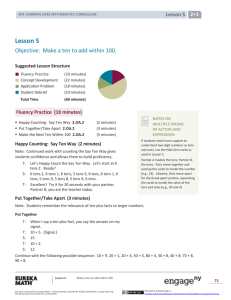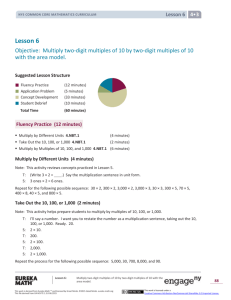Grade 4 Mathematics Module 3, Topic H, Lesson 34
advertisement
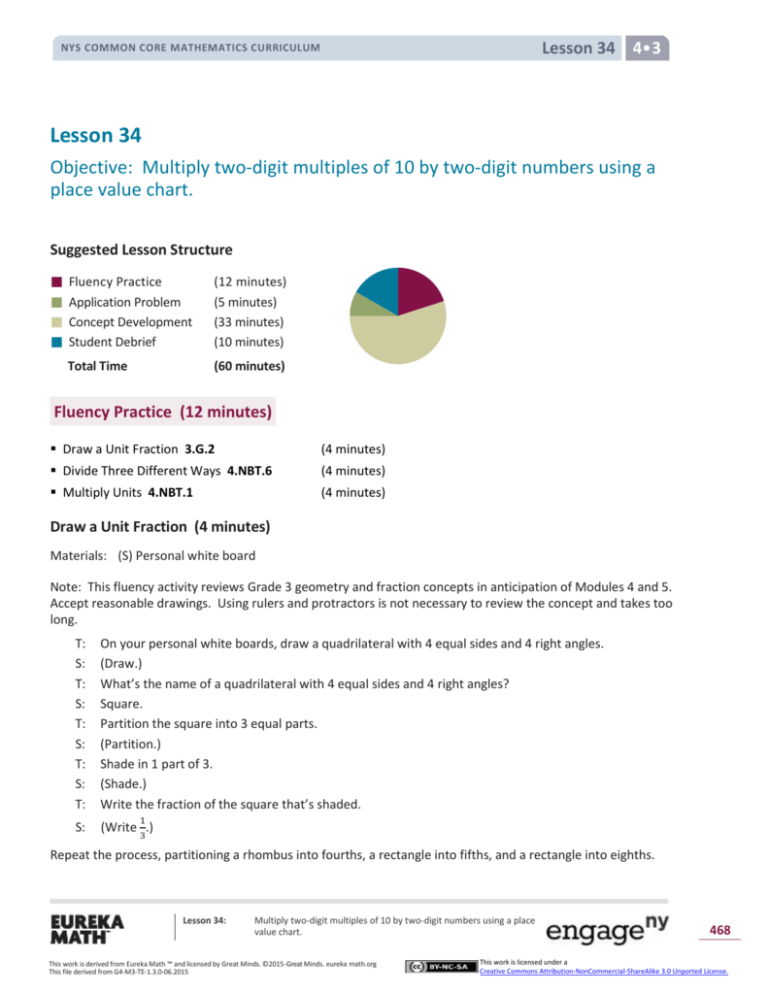
Lesson 34 4 3 NYS COMMON CORE MATHEMATICS CURRICULUM Lesson 34 Objective: Multiply two-digit multiples of 10 by two-digit numbers using a place value chart. Suggested Lesson Structure Fluency Practice Application Problem Concept Development Student Debrief Total Time (12 minutes) (5 minutes) (33 minutes) (10 minutes) (60 minutes) Fluency Practice (12 minutes) Draw a Unit Fraction 3.G.2 (4 minutes) Divide Three Different Ways 4.NBT.6 (4 minutes) Multiply Units 4.NBT.1 (4 minutes) Draw a Unit Fraction (4 minutes) Materials: (S) Personal white board Note: This fluency activity reviews Grade 3 geometry and fraction concepts in anticipation of Modules 4 and 5. Accept reasonable drawings. Using rulers and protractors is not necessary to review the concept and takes too long. T: S: T: S: T: S: T: S: T: On your personal white boards, draw a quadrilateral with 4 equal sides and 4 right angles. (Draw.) What’s the name of a quadrilateral with 4 equal sides and 4 right angles? Square. Partition the square into 3 equal parts. (Partition.) Shade in 1 part of 3. (Shade.) Write the fraction of the square that’s shaded. S: (Write 3.) 1 Repeat the process, partitioning a rhombus into fourths, a rectangle into fifths, and a rectangle into eighths. Lesson 34: Multiply two-digit multiples of 10 by two-digit numbers using a place value chart. This work is derived from Eureka Math ™ and licensed by Great Minds. ©2015 -Great Minds. eureka math.org This file derived from G4-M3-TE-1.3.0-06.2015 468 This work is licensed under a Creative Commons Attribution-NonCommercial-ShareAlike 3.0 Unported License. Lesson 34 4 3 NYS COMMON CORE MATHEMATICS CURRICULUM Divide Three Different Ways (4 minutes) Materials: (S) Personal white board Note: This fluency activity reviews content from Lessons 32 and 33. T: S: T: S: T: S: (Write 732 ÷ 6.) Solve this problem by drawing place value disks. (Solve.) Solve 732 ÷ 6 using the area model. (Solve.) Solve 732 ÷ 6 using the standard algorithm. (Solve.) Continue with this possible suggestion: 970 ÷ 8. Multiply Units (4 minutes) Materials: (S) Personal white board Note: This fluency activity reviews Lesson 4. T: S: T: S: T: S: T: S: T: S: T: S: T: S: T: S: (Write 4 ones × 3.) Solve. Say the multiplication sentence in unit form. 4 ones × 3 = 12 ones. Write the equation in standard form. (Write 4 × 3 = 12.) (Write 4 tens × 3.) Solve. Write the equation in standard form. (Write 40 × 3 = 120.) (Write 4 tens × 3 tens.) Solve. Write the equation in standard form. (Write 40 × 30 = 1,200.) (Write 3 × 2.) Solve. Say the multiplication sentence. 3 × 2 = 6. Write the equation in unit form. (Write 3 ones × 2 = 6 ones.) (Write 30 × 2.) Solve. Write the equation in unit form. (Write 3 tens × 2 = 6 tens.) (Write 30 × 20.) Solve. Write the equation in unit form. (Write 3 tens × 2 tens = 6 hundreds.) Continue with the following possible sequence: 30 × 5, 30 × 50, 3 tens × 6, 3 tens × 6 tens, 50 × 4, 5 tens × 8 tens, and 60 × 50. Lesson 34: Multiply two-digit multiples of 10 by two-digit numbers using a place value chart. This work is derived from Eureka Math ™ and licensed by Great Minds. ©2015 -Great Minds. eureka math.org This file derived from G4-M3-TE-1.3.0-06.2015 469 This work is licensed under a Creative Commons Attribution-NonCommercial-ShareAlike 3.0 Unported License. Lesson 34 4 3 NYS COMMON CORE MATHEMATICS CURRICULUM Application Problem (5 minutes) Mr. Goggins planted 10 rows of beans, 10 rows of squash, 10 rows of tomatoes, and 10 rows of cucumbers in his garden. He put 22 plants in each row. Draw an area model, label each part, and then write an expression that represents the total number of plants in the garden. (4 × 10) × 22 Note: This Application Problem builds on Topic B, where students learned to multiply by multiples of 10, and Topic C, where students learned to multiply two-digit by one-digit numbers using an area model. This Application Problem helps bridge to today’s lesson as students learn to multiply multiples of 10 by two-digit numbers. Concept Development (33 minutes) Materials: (S) Personal white board, thousands place value chart (Lesson 4 Template) Problem 1: Discover that 4 × 10 × 22 and 40 × 22 represent the same amount. T: T: S: T: S: T: S: T: S: T: S: Look at the area model that we drew for the Application Problem. (Erase the names of the plants.) How many 10 × 22 rectangles are there in the model? 4. Write an expression to show the entire length of the rectangle. (Indicate the vertical side length). 4 × 10. What is the area formula? Length times width. Discuss with your partner an expression to show the total area of the largest rectangle. 40 times 22. (4 × 10) × 22. What can we say about the expressions (4 × 10) × 22 and 40 × 22? They represent the same amount. Lesson 34: Multiply two-digit multiples of 10 by two-digit numbers using a place value chart. This work is derived from Eureka Math ™ and licensed by Great Minds. ©2015 -Great Minds. eureka math.org This file derived from G4-M3-TE-1.3.0-06.2015 470 This work is licensed under a Creative Commons Attribution-NonCommercial-ShareAlike 3.0 Unported License. Lesson 34 4 3 NYS COMMON CORE MATHEMATICS CURRICULUM T: S: T: S: T: How can you tell? Turn and talk to your partner. The total length is 4 tens. We can write 4 tens as 4 times 10 or 40. You can either find the area of the smallest rectangle and multiply it by four or just multiply 40 times 22. We can say that 40 × 22 = 4 × 10 × 22 or 10 × 4 × 22. Yes. That’s good because we can solve 4 times 10 times 22, but 40 times 22 is new territory. Problem 2: Multiply 40 × 22 using a place value chart. Write: T: T: S: T: S: T: S: T: S: T: S: 40 × 22 = (4 × 10) × 22 40 × 22 = 4 × (10 × 22) 40 × 22 = 10 × (4 × 22) Show 22 on your place value chart. Show 10 times as many. 10 × 22 is? (Draw disks to show 22, and then draw arrows to show 10 times that amount.) How many hundreds? How many tens? 2 hundreds and 2 tens. Show 4 times as many. (Draw disks to show 3 more groups of 2 hundreds 2 tens.) Tell how many you have now. 8 hundreds and 8 tens. What number does that represent? Say the number sentence. 4 × (10 × 22) = 880. 40 × 22 = 880. Repeat the process, this time beginning by multiplying 22 by 4 as in the model above and to the right. (Write 40 × 22 = (10 × 4) × 22 = 10 × (4 × 22).) Lesson 34: Multiply two-digit multiples of 10 by two-digit numbers using a place value chart. This work is derived from Eureka Math ™ and licensed by Great Minds. ©2015 -Great Minds. eureka math.org This file derived from G4-M3-TE-1.3.0-06.2015 471 This work is licensed under a Creative Commons Attribution-NonCommercial-ShareAlike 3.0 Unported License. Lesson 34 4 3 NYS COMMON CORE MATHEMATICS CURRICULUM Next, have students see that they can conceive of the problem as 40 times 22, as pictured below, without breaking the process into the two steps of multiplying by 4 and 10 in whatever order. Problem 3: Multiply 50 × 31 using a place value chart. T: S: T: S: T: S: T: T: S: T: S: T: S: T: S: T: S: What is another way to express 50 × 31? NOTES ON MULTIPLE MEANS 10 × (5 × 31). 5 × (10 × 31). OF REPRESENTATION: Tell your partner why you chose to represent 50 using the numbers 5 and 10. You may present the following scaffolds to assist students in 50 = 5 × 10. I know how to multiply by 10 and by 5, but organizing and keeping track of arrays I don’t know how to multiply by 50. of place value disks: Yes, you are using the associative property, which Alternate colors as they draw 5 rows allows us to use the factors of a number to help us of 3 hundreds. multiply. What factors did we use for 50? Give extra time to model. 5 and 10. Couple disks with words (e.g., 3 hundreds × 5). Show 31 on your place value chart. Use manipulatives at first, and then Show 10 times as many. transition to drawings. (Draw disks to show 31, and then draw arrows to show 10 times that amount.) How many hundreds? How many tens? 3 hundreds and 1 ten. Show 5 times as many. (Draw disks to show 4 more groups of 3 hundreds 1 ten.) Tell how many you have now. 15 hundreds and 5 tens. I change 10 hundreds for one thousand. I have 1 thousand, 5 hundreds, and 5 tens. What number does that represent? 1,550. Lesson 34: Multiply two-digit multiples of 10 by two-digit numbers using a place value chart. This work is derived from Eureka Math ™ and licensed by Great Minds. ©2015 -Great Minds. eureka math.org This file derived from G4-M3-TE-1.3.0-06.2015 472 This work is licensed under a Creative Commons Attribution-NonCommercial-ShareAlike 3.0 Unported License. Lesson 34 4 3 NYS COMMON CORE MATHEMATICS CURRICULUM Problem 4: Multiply 50 × 31 without using a place value chart. T: S: T: T: S: T: S: T: S: T: S: T: S: T: S: 50 × 31 is the same 50 × (30 + 1). Discuss with your partner why this is true. We drew 31 as 3 tens and 1 one on the place value chart and multiplied each unit by 50. 50 groups of 31 is the same as 50 groups of 30 and 50 groups of 1. It’s the break apart and distribute property! It’s the distributive property! 50 × (30 + 1) = 50 × 30 + 50 × 1. Can you see that on our place value chart? (Show that on the place value chart.) At first, we broke apart 50 into 10 × 5 or 5 × 10, but, in the end, we just thought of it as 50 × 31. Let’s say 50 × 30 + 50 × 1 in unit language. 5 tens × 3 tens + 5 tens × 1 one. 5 tens times 3 tens is…? 15 hundreds. 5 tens times 1 one is…? 5 tens. 15 hundreds + 5 tens is…? 1,550. 50 × 31 is…? 1,550. Did we get the same product just by multiplying that we did when we used the chart? Yes. NOTES ON MULTIPLE MEANS OF ENGAGEMENT: Challenge students working above grade level to do mental computations. For example, students can use the distributive property to think of 6 × 560 as (6 × 500) + (6 × 60) and then solve using what they know about multiplying multiples of 10. Students who are not ready for the mental computations may continue to draw the area model used in previous lessons to confirm their final product. Problem Set (10 minutes) Students should do their personal best to complete the Problem Set within the allotted 10 minutes. For some classes, it may be appropriate to modify the assignment by specifying which problems they work on first. Some problems do not specify a method for solving. Students should solve these problems using the RDW approach used for Application Problems. Lesson 34: Multiply two-digit multiples of 10 by two-digit numbers using a place value chart. This work is derived from Eureka Math ™ and licensed by Great Minds. ©2015 -Great Minds. eureka math.org This file derived from G4-M3-TE-1.3.0-06.2015 473 This work is licensed under a Creative Commons Attribution-NonCommercial-ShareAlike 3.0 Unported License. Lesson 34 4 3 NYS COMMON CORE MATHEMATICS CURRICULUM Student Debrief (10 minutes) Lesson Objective: Multiply two-digit multiples of 10 by two-digit numbers using a place value chart. The Student Debrief is intended to invite reflection and active processing of the total lesson experience. Invite students to review their solutions for the Problem Set. They should check work by comparing answers with a partner before going over answers as a class. Look for misconceptions or misunderstandings that can be addressed in the Debrief. Guide students in a conversation to debrief the Problem Set and process the lesson. Any combination of the questions below may be used to lead the discussion. In Problem 1(a), is it best to model 30 or 24 on the chart initially? Why? Tell your partner how you used the associative property in Problem 3(a). Is there an order you find easier for multiplying the three factors like when multiplying using the place value chart? Why was it helpful to break the multiple of 10 into two factors before solving? How did distributing the second factor in Problem 4 of the Concept Development make it easier to solve? Compare Problems 3(a) and 4(a). Why did you get the same answer by using two different methods? What does this tell you about the associative and distributive property? Compare their processes. How are they different? How did representing the multiplication with disks help you solve and understand the multiplication? How did the Application Problem connect to today’s lesson? Exit Ticket (3 minutes) After the Student Debrief, instruct students to complete the Exit Ticket. A review of their work will help with assessing students’ understanding of the concepts that were presented in today’s lesson and planning more effectively for future lessons. The questions may be read aloud to the students. Lesson 34: Multiply two-digit multiples of 10 by two-digit numbers using a place value chart. This work is derived from Eureka Math ™ and licensed by Great Minds. ©2015 -Great Minds. eureka math.org This file derived from G4-M3-TE-1.3.0-06.2015 474 This work is licensed under a Creative Commons Attribution-NonCommercial-ShareAlike 3.0 Unported License. Lesson 34 Problem Set 4 3 NYS COMMON CORE MATHEMATICS CURRICULUM Name Date 1. Use the associative property to rewrite each expression. Solve using disks, and then complete the number sentences. a. 30 × 24 hundreds tens ones hundreds tens ones tens ones = ( ____ × 10) × 24 = ____ × (10 × 24) = _______ thousands b. 40 × 43 = (4 × 10) × _____ = 4 × (10 × ___ ) = _______ thousands c. 30 × 37 hundreds = (3 × ____ ) × _____ = 3 × (10 × _____ ) = _______ Lesson 34: Multiply two-digit multiples of 10 by two-digit numbers using a place value chart. This work is derived from Eureka Math ™ and licensed by Great Minds. ©2015 -Great Minds. eureka math.org This file derived from G4-M3-TE-1.3.0-06.2015 475 This work is licensed under a Creative Commons Attribution-NonCommercial-ShareAlike 3.0 Unported License. NYS COMMON CORE MATHEMATICS CURRICULUM Lesson 34 Problem Set 4 3 2. Use the associative property and place value disks to solve. a. 20 × 27 b. 40 × 31 3. Use the associative property without place value disks to solve. a. 40 × 34 b. 50 × 43 4. Use the distributive property to solve the following problems. Distribute the second factor. a. 40 × 34 b. 60 × 25 Lesson 34: Multiply two-digit multiples of 10 by two-digit numbers using a place value chart. This work is derived from Eureka Math ™ and licensed by Great Minds. ©2015 -Great Minds. eureka math.org This file derived from G4-M3-TE-1.3.0-06.2015 476 This work is licensed under a Creative Commons Attribution-NonCommercial-ShareAlike 3.0 Unported License. Lesson 34 Exit Ticket 4 3 NYS COMMON CORE MATHEMATICS CURRICULUM Name Date 1. Use the associative property to rewrite each expression. Solve using disks, and then complete the number sentences. 20 × 41 hundreds tens ones ____ × ____ × ____ = ____ 2. Distribute 32 as 30 + 2 and solve. 60 × 32 Lesson 34: Multiply two-digit multiples of 10 by two-digit numbers using a place value chart. This work is derived from Eureka Math ™ and licensed by Great Minds. ©2015 -Great Minds. eureka math.org This file derived from G4-M3-TE-1.3.0-06.2015 477 This work is licensed under a Creative Commons Attribution-NonCommercial-ShareAlike 3.0 Unported License. Lesson 34 Homework 4 3 NYS COMMON CORE MATHEMATICS CURRICULUM Name Date 1. Use the associative property to rewrite each expression. Solve using disks, and then complete the number sentences. a. 20 × 34 hundreds tens ones = (____ × 10) × 34 = ____ × (10 × 34) = _______ thousands b. 30 × 34 hundreds tens ones = (3 × 10) × _____ = 3 × (10 × ___) = _______ thousands hundreds tens ones c. 30 × 42 = (3 × ____) × _____ = 3 × (10 × _____) = _______ Lesson 34: Multiply two-digit multiples of 10 by two-digit numbers using a place value chart. This work is derived from Eureka Math ™ and licensed by Great Minds. ©2015 -Great Minds. eureka math.org This file derived from G4-M3-TE-1.3.0-06.2015 478 This work is licensed under a Creative Commons Attribution-NonCommercial-ShareAlike 3.0 Unported License. NYS COMMON CORE MATHEMATICS CURRICULUM Lesson 34 Homework 4 3 2. Use the associative property and place value disks to solve. a. 20 × 16 b. 40 × 32 3. Use the associative property without place value disks to solve. a. 30 × 21 b. 60 × 42 4. Use the distributive property to solve the following. Distribute the second factor. a. 40 × 43 b. 70 × 23 Lesson 34: Multiply two-digit multiples of 10 by two-digit numbers using a place value chart. This work is derived from Eureka Math ™ and licensed by Great Minds. ©2015 -Great Minds. eureka math.org This file derived from G4-M3-TE-1.3.0-06.2015 479 This work is licensed under a Creative Commons Attribution-NonCommercial-ShareAlike 3.0 Unported License.



